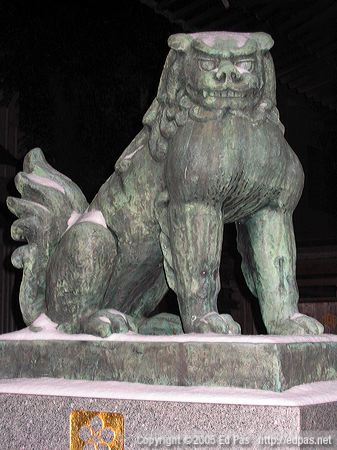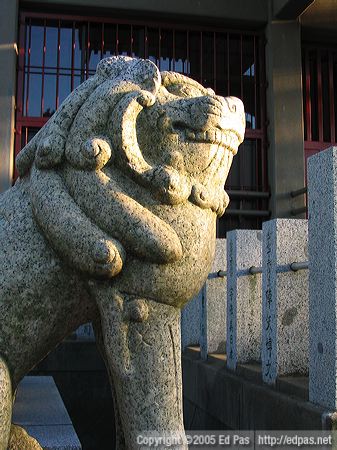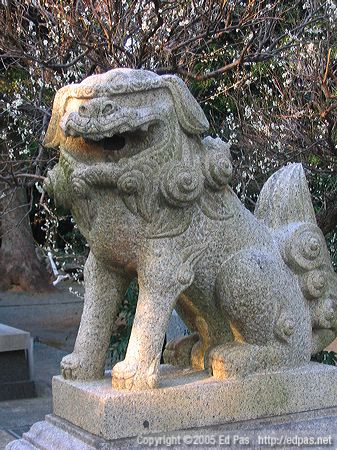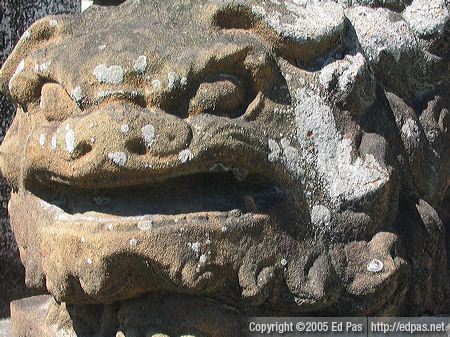Are they lions or dogs? Why is one open-mouthed and the other closed-mouthed? What are they doing at shrines all over Japan? Well, I’ve found some of the answers. Secrets of the Japanese shishi—also known as koma-inu —will be revealed at last! The creatures are, in fact, lions. Or dogs. Or lion-dogs. One explanation of the mouths is that the open mouth is to scare away evil spirits, and the closed mouth is to keep in good spirits.
For those of you with short attention spans, the rest of this post is mostly just further details about the quadrupeds in question, a little bit of background about why I chose today’s topic. Plus many many pictures.
I’m going to start off by saying that I don’t know which term is more common, shishi or koma-inu, but I’m going to stick with the former. Mostly because it’s easier for me to remember. With that said, let’s get on with it.
Here’s a view of a shrine near Enkakuji Temple in Kurate Town just outside of Kitakyushu. We went to this Buddhist temple at the end of December 2004 to make mochi (pounded sticky rice) with some of the teachers from my school. The group included the priest’s son, who happened to be an English teachers at my school at the time. He’s since been transferred to a different school, an event that was unlikely to have been precipitated by the fact that he is also a Buddhist priest. All of which has very little to do with the photo showing a pair of shishi in their natural environment in front of a Shinto shrine.

What sent me on the quest for the arcane lore of the shishi? Two things. First of all, on my post from the beginning of June that was dominated by the flower photos from Yatsurugi Shrine, Yu Lin mentioned that the guardian was probably a kind of lion. She said:
Lions are used in front of many temple doors or gates to guard the place. Let me know if I am right on this when you find out.
And secondly, when Amy and April were here at the end of May, we visited a couple of shrines together. Amy asked me why one of the guardian animals had its mouth open and the other had its mouth closed. Not wanting to damage my reputation as a know-it-all, I was compelled to do some actual research.
Which is a nice segue into the educational part of today’s program. According to this shrine guide they are called shishi or koma-inu:
A pair of Shishi (lion-dogs; also called Koma-inu) traditionally stand guard outside the gates of Japanese Shinto shrines. In contrast, Buddhist temples are typically guarded by the Nio Protectors, although it is not uncommon to find Shishi guarding temples as well. Furthermore, on the eaves of both shrine and temple roofs, one can frequently find carvings of this mythical beast.
As guardians outside the shrine gate, one shishi is depicted with its mouth open (to scare off demons) and the other with its mouth closed (to shelter and keep in the good spirits). Another traditional explanation for the open/closed mouth relates to Ah and Un (“Ah” is the first letter in the Japanese alphabet and “Un” is the last, just as in Sanskrit). The combination is said to symbolically represent birth and death.
This mythical and magical beast was probably introduced to Japan from China and/or Korean in the 7th or 8th century AD, during the same period as Buddhism’s transmission to Japan, for the Japanese shishi combines elements of both the Korean “Koma-inu” (Korean dog) and Chinese “Kara-shishi” (Chinese lion).
So Yu Lin, you were right.
Moving closer to home, here is a pair of bronze lion dogs that I photographed at Sugawara Jinja, a shrine in our neighbourhood that I wrote about in April. You can also see them in the last picture of that post, which has a very similar composition to the photo above, though the Sugawara photo was taken on a snowy night. As were these two pictures. First up is the closed-mouthed one, on the left side of the path.

Next is the closed-mouthed shishi on the right side of the path.

Konpira Shrine is a bit further afield, but still within easy walking distance of our apartment. It’s at the top of Konpira Mountain, which is visible from our building. The mountain has a gently sloping spiral road to the top that is approximately 1.6 kilometers long. The alternate path is a steep, uneven stairway that I vaguely remember being over three hundred steps the time I climbed it.
The afternoon I took this photo I didn’t see anyone on the stairs, but there were many people walking up the road. They seemed surprised to see someone—me—cycling up. Once they got to the top, some stopped for water—giving new meaning to the phrase “went up the hill to fetch a pail of water”—and some took a toilet break before they headed back down. Others spent a long time doing stretching exercises inside the shrine grounds, oblivious to the fact that I was waiting for clear sightlines.
I’ll save the photos of Konpira Shrine for another post. Here’s one of the shishi. Having his mouth closed doesn’t seem to be stopping him from showing off his fine dental work.

This one is from a shrine on a hill near my school. I’m not sure of the name of the shrine, but it’s between the school and the art museum. This guardian looks more tired than fearsome. I think he’s yawning rather than trying to scare me, maybe because he’s seen too people with cameras.

And here’s another one in Kitakyushu, this time in Kokura minami. Again, I don’t know the name of the shrine. It’s somewhere near the highway that leads to Tagawa City. Which is about as precise a description of the location as “it’s over yonder.”

This is from a shrine in the Mojiko district of Kitakyushu, near the extreme northern tip of Kyushu. This is yet another case wehre I don’t know the name of the shrine, but I’m sure it’s not the Mekari Shrine, which overlooks the Kanmon Strait and faces Japan’s main island of Honshu.

I’ll finish off for today with two from a seemingly abandoned shrine about a hundred meters from a beach in one direction, and a fishing harbour in the other, on the coast between Ashiya Town and Kitakyushu’s Wakamatsu ward. I think these two guardians traded jobs.
This guy looks like he’s a bit stunned, having been tricked into opening his mouth and thereby releasing all of the good spirits.

And this appears to be the fierce guardian type. He’s wearing the expression of someone who’s just been told that his idiot partner has recently given away the keys to the vault. Or opened his mouth when he wasn’t supposed to.

That’s it for my lion dog photos from the Kitakyushu area. In the second installment I’ll continue with more photos—from further afield—including Dazaifu Tenmangu shrine, Udo Jinja in Miyazaki, Itsukushima Shrine in Hiroshima, and more. And in the third installment I’ll throw in some rampant speculation about the mythic origins of these fine beasts, followed by the fourth and final post, which consists of footnotes, explanations, and poetry.
If you can’t wait for more, the site I took the above long quote from also has a page with further explanation and description of shishi, complete with many photos. Though by now, more pictures of stone dogs is probably the last thing you’ll want to look at. Then again, it’s up to you to decide if you want more, so here’s the link.
I was also wondering what the symbolism was regarding the closed mouth always on the left and the opened mouth always on the right, even the crow/raven statues at one of the temples had open/right, closed/left pattern… perhaps the open=yang=right=male? who knows?
In Taiwan there is one male and one female lion in a pair. The female usually has a small lion under one paw, the male (if memory serves) has a ball. Interesting to see the evolution across Asia. Rooawwr!